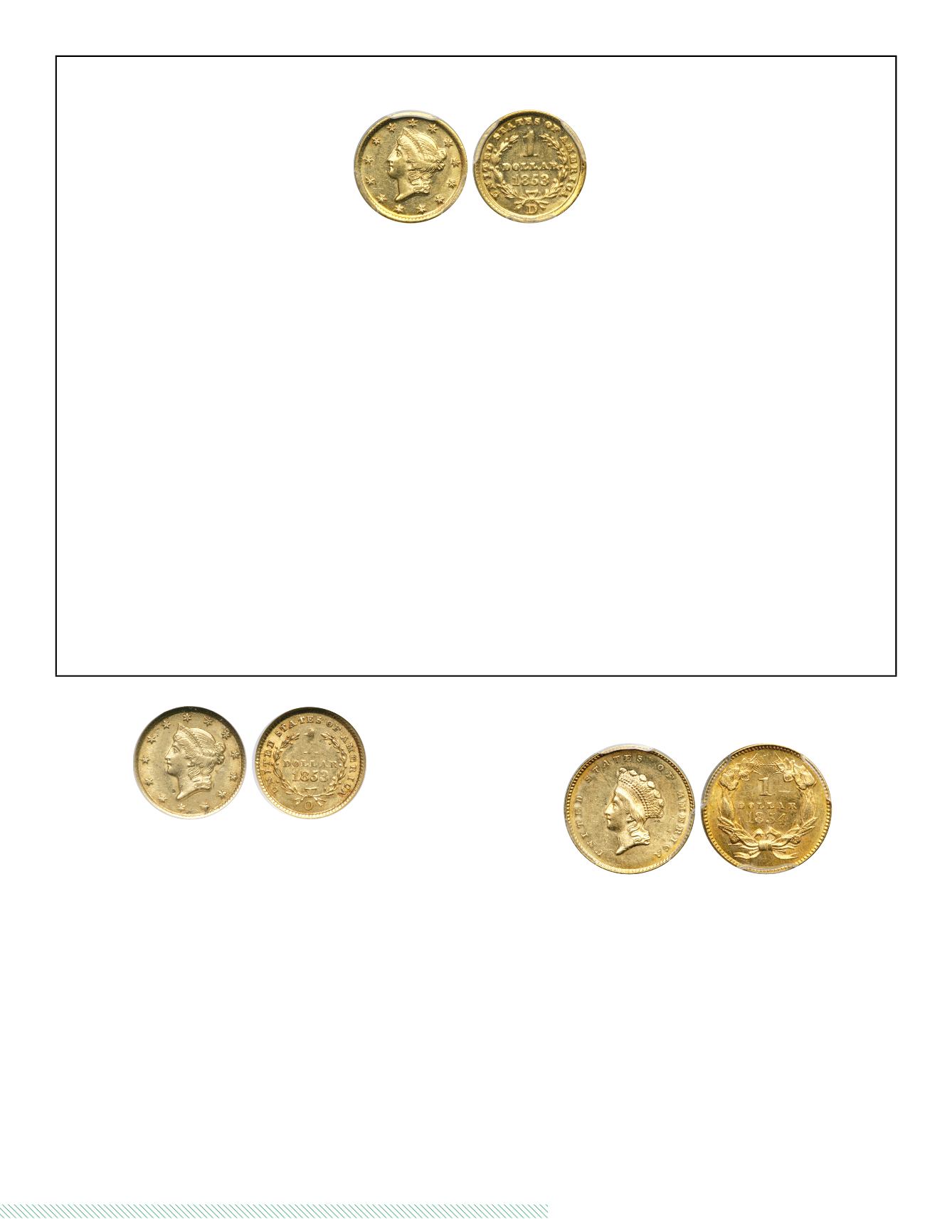
1
241
bid online at
(800) 978-COIN (2646)
|
Session Four - Tuesday, June 3, 2014 6:00 PM
M
INT
S
TATE
1853-D $1 G
OLD
L
IBERTY
Enlargement
1653
1853-D
.
PCGS graded MS-62
. A nice untoned coin. Only 6,583 minted. Lustrous light yellow gold with nice select surfaces tending toward
somewhat prooflike condition. The quality of this example is exceeded by a few others, if any other survivors from the mintage are available
just now, which doesn’t seem likely. Generally well struck with very slight weakness on the highest points of the hair and mostly confined to
the rim dentils. The borders are rarely bold and complete on D-mint issues. It appears that three 1853-D reverse dies were supplied to the
Dahlonega Mint, but that just one of these was used to produce the recorded mintage. Sufficient obverse dies still remained on hand. In his
Encyclopedia Walter Breen comments: "usually poorly struck." The same remark could be repeated throughout the present sale or any other
offering of Dahlonega Mint (or Charlotte Mint) issues.
A comment in the section below explains why this Mint may have struck only Gold Dollars, Quarter Eagles, and Half Eagles, but nothing larger
in its years in operation, 1838-61.
Pop 3; 7 finer, 4 in 63, 3 in 65
. (
PCGS # 7523
)
Historic note on the Dahlonega Mint: The remote location of this facility caused an array of construction and staffing problems. One would not
expect to find skilled workmen and quality building materials in such a backwoods community, but the failure of the mother mint at Philadel-
phia to foresee and compensate for these problems only aggravated the situation. For example, the problems encountered with the making of
brick could have been easily avoided by specifying granite or limestone, which were regional specialties, as just one instance.
Juxtaposed with the rusticity of the community in which it was to operate, the mint was to be supplied with the latest in automated coining
equipment. The most revolutionary were two steam presses, invented by Franklin Peale, a mainstay at the Philadelphia Mint, based on his
recent observations in Europe, and first incorporated in the primary mint in 1836. The presses were probably the "small" version, rendering
them incapable of producing coins larger than a half eagle. The presses, and other associated equipment, were shipped in 15 boxes to Savan-
nah, Georgia, sent upriver to Augusta, then hauled overland by wagon to Dahlonega.
Due to reports of the construction difficulties reaching Philadelphia, the primary mint dispatched its crack troubleshooter, Franklin Peale, who
arrived in Dahlonega in November 1837, along with his daughter, after inspecting the Charlotte facility. Close scrutiny of the Dahlonega Mint
edifice revealed many problems, the blame for which Peale assigned to "ignorance on the part of the contractor and the drunken and bad
habits of the workmen."
Estimated Value ........................................................................................................................................................... $11,000 - 12,000
Enlargement
1654
1853-O
.
NGC graded MS-61
. A frosty, well-impressed gold
dollar that has sharp stars. Only the "1" in the denomination is
weak. Struck at the New Orleans Mint, which made Gold Dollars
from 1849 until 1855 (skipping only the year 1854 when none
were issued by this facility). We note two small planchet flakes
at the point of the bust and nearby. (
PCGS # 7524
)
Estimated Value ................................................... $375 - 400
$1 Ind i an
Enlargement
1655
1854. Type 2
.
PCGS graded MS-61
. Well struck and mostly
untoned. Attractive Type 2 coin, and the year that has the best
strike quality in this short series (1854-56). Due to difficulties
faced by the mint, most later strikes (1855-56) suffered weak
areas and the innovative design had to be revised by flattening
the relief on the Indian head as well as restyling it. (
PCGS #
7531
)
Estimated Value ..............................................$1,500 - 1,600


